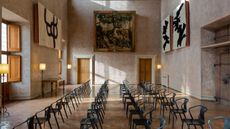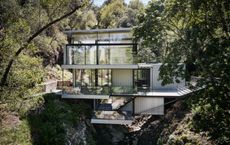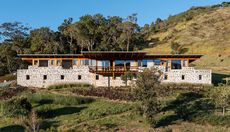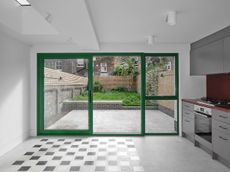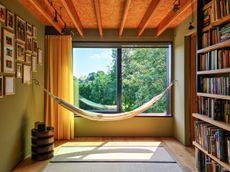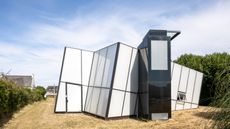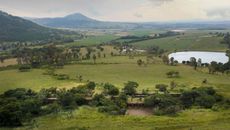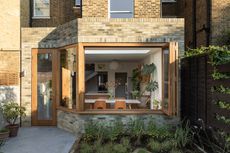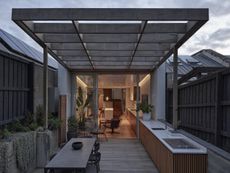Casa Azul brings sensitive modern architecture to the Atlantic Forest
The latest project from Studio MK27, a beachside residence in the Brazilian rainforest, lives in harmony with nature at every level
- (opens in new tab)
- (opens in new tab)
- (opens in new tab)
- Sign up to our newsletter Newsletter

Casa Azul may be the latest in a long line of residential masterpieces by Marcio Kogan and his partners at Studio MK27, but it is unique among its distinguished cohort for its site, a rare parcel within the protected Atlantic Forest that has shaped this project in every way. Located in Guarujá, Brazil, in the state of São Paulo, with the stunning Iporanga Beach and Atlantic Ocean a mere 500m away, Casa Azul is a study in sustainable architecture and development and contemporary Brazilian architecture.
Understandably, the local municipality was strict about its construction. It took nearly two years to secure the required environmental agency approvals, which mandated a 2m-wide protective bubble beyond the footprint of the home to shield the forest from building activity. Officials were on site daily to inspect the impact of the project on the surrounding flora, but Kogan, Diana Radomysler (he co-heads the studio with her, Renata Furlanetto, Suzana Glogowski and Mariana Simas) and their co-designer Samanta Cafardo were more than happy to comply with strict environmental oversight, and to go even further.

The ground floor deck features a swimming pool and plenty of shade
‘Our goal was to truly integrate the house into the surrounding forest,’ says Cafardo. ‘When you look at this amazing place, it’s impossible to not want to protect it.’ The team was successful in their efforts, completely preserving the existing landscape throughout the process, and ultimately aiming to qualify for the highest building credential certification from Brazil’s Green Building Council (GBC Brasil). They have now applied for it and expect the results later this year. In the same spirit, the wood used to make the handful of furniture pieces that were custom designed by the team was sourced from responsibly-managed forests and certified by Brazil’s Forest Stewardship Council.
Casa Azul’s relatively small building footprint of 350 sq m forced Studio MK27 to rethink its long-held beliefs about residential scale. The practice’s projects are typically long, low-slung structures that sit in elegant humility on the landscape, always deferring to nature. Here, that deference and the aforementioned environmental restrictions meant going slightly more vertical, which has been done with spectacular results. While the house is taller than typical Studio MK27 projects, it has an incredibly light visual presence, its almost transparent structure living in harmony with nature from the bottom up. The ground floor is a wooden deck in an enchantingly amorphous shape, entirely open to the surrounding forest, with landscaping done by Rodrigo Oliveira. It pays homage to the work of legendary Brazilian landscape architect Roberto Burle Marx and offers an intentional contrast with the rectangular concrete boxes above. While the form of the decking is reminiscent of Marx’s works, it was driven as much by a dedication to preserving every single existing tree on the parcel – an amenity valued even more than having a larger swimming pool.

The first-level concrete box frames views of the surrounding foliage and functions as a verandah when the glass panels are open
The two stacked volumes above make up the house’s living spaces. Both are cantilevered off an entry core and offset from each other, creating a dramatic 15m span that makes the house appear to float above the rainforest floor. The first level has a telescoping glass-panel system on both sides of the building, giving the house its transparent look and feel, as well as energy-saving cross-ventilation. The concrete box – itself creating an open, loft-style floor plan that includes the kitchen and living spaces – frames views of the crowns that top the surrounding trees and functions as a large verandah when the windows are fully open. The house sits so close to the treetops that Kogan jokes: ‘Our clients can’t leave their bananas on the kitchen counter.’
The second level houses four bedrooms, each looking out over the rainforest’s canopy. This floor stands out for its elegant wooden screens, mounted in front of glass panels. The screens are a functional and cultural nod to the traditional light-diffusing muxarabi screens that were originally brought to southern Portugal by the invading Moors in the eighth century and which would eventually become part of the Portuguese aesthetic that was exported to Brazil and other parts of the lusophone world in the centuries that followed.

The house is nestled at the edge of the Atlantic Forest, a mere 500m away from the stunning Iporanga Beach
Studio MK27 originally planned to paint these screens in their traditional light blue, the same colour that accents most of the historic Portuguese colonial structures across Brazil, hence the name Casa Azul. However, the team eventually opted for a natural wood finish on the screens to further blend the house with the forest, rather than draw a contrast. Despite the change, the ‘Blue House’ moniker was retained.
The original idea for the screens is a hint at what sets Studio MK27 apart. The studio has advanced the legacy of Brazilian architecture over the last 20 years with a body of work that embraces the modern gestalt, while taking historical cues from the Portuguese colonial era and prior Indigenous cultures that shaped contemporary Brazil. Casa Azul perfectly exemplifies the studio’s trademark style – a clean, disciplined modernism that boasts a rich palette of natural materials, a focus on craftsmanship, and an inherent reverence for both the past and nature.

In one of the four bedrooms, a latticed panel nods to traditional Moorish muxarabi screens
INFORMATION
studiomk27.com.br (opens in new tab)
A version of this article appears in the June 2022 Escapes Issue of Wallpaper*. Subscribe (opens in new tab) today!
-
 Fendi collaborates on a new modern interpretation of Rome’s Villa Medici interiors
Fendi collaborates on a new modern interpretation of Rome’s Villa Medici interiorsFendi and the French Academy in Rome joined forces to restore six historic salons at Villa Medici, in collaboration with Mobilier National
By Rosa Bertoli • Published
-
 Year in review: top 10 beauty moments, trends and launches of 2022, from Wallpaper’s Mary Cleary
Year in review: top 10 beauty moments, trends and launches of 2022, from Wallpaper’s Mary ClearyTop 10 beauty moments of 2022, from Wallpaper beauty & grooming editor Mary Cleary – from Dries Van Noten’s make-up to Julien d’Ys’ garbage sculptures and how to lucid dream
By Mary Cleary • Published
-
 Mac Collins explores identity and empowerment through design
Mac Collins explores identity and empowerment through designPart of Wallpaper’s Future Icons series, Mac Collins tells us about his design work, and inspiring the next generation
By Sujata Burman • Published
-
 Year in review: top 10 houses of 2022, selected by Wallpaper* architecture editor Ellie Stathaki
Year in review: top 10 houses of 2022, selected by Wallpaper* architecture editor Ellie StathakiWallpaper’s Ellie Stathaki reveals her top 10 houses of 2022 – from modernist reinventions to urban extensions and idyllic retreats
By Ellie Stathaki • Published
-
 This Brazil mountain retreat is a ‘timeless ruin‘
This Brazil mountain retreat is a ‘timeless ruin‘Bocaina-Paraty House is a timeless Brazil mountain retreat by architects Cicero Ferraz Cruz and Fábio Mosaner
By Ellie Stathaki • Published
-
 Roz Barr’s terrace house extension is a minimalist reimagining
Roz Barr’s terrace house extension is a minimalist reimaginingTerrace house extension by Roz Barr Architects transforms Victorian London home through pared-down elegance
By Nick Compton • Published
-
 Tree View House blends warm modernism and nature
Tree View House blends warm modernism and natureNorth London's Tree View House by Neil Dusheiko Architects draws on Delhi and California living
By Ellie Stathaki • Published
-
 Maison de Verre: a dramatic glass house in France by Studio Odile Decq
Maison de Verre: a dramatic glass house in France by Studio Odile DecqMaison de Verre in Carantec is a glass box with a difference, housing a calming interior with a science fiction edge
By Jonathan Bell • Published
-
 Modernist Coromandel farmhouse refreshed by Frankie Pappas, Mayat Hart and Thomashoff+Partner
Modernist Coromandel farmhouse refreshed by Frankie Pappas, Mayat Hart and Thomashoff+PartnerAn iconic Coromandel farmhouse is being reimagined by the South African architectural collaborative of Frankie Pappas, Mayat Hart and Thomashoff+Partner
By Nick Compton • Last updated
-
 East London house extension infuses Victorian home with warm modernism
East London house extension infuses Victorian home with warm modernismBlurton Road by London architecture studio Emil Eve is a residential extension project that transforms a modest Clapton house
By Ellie Stathaki • Published
-
 Pergola Extension transforms Victorian Melbourne home
Pergola Extension transforms Victorian Melbourne homePergola Extension by Krisna Cheung Architects offers a contemporary touch to a Victorian Melbourne property, infusing it with sustainability and generosity of space
By Ellie Stathaki • Last updated
